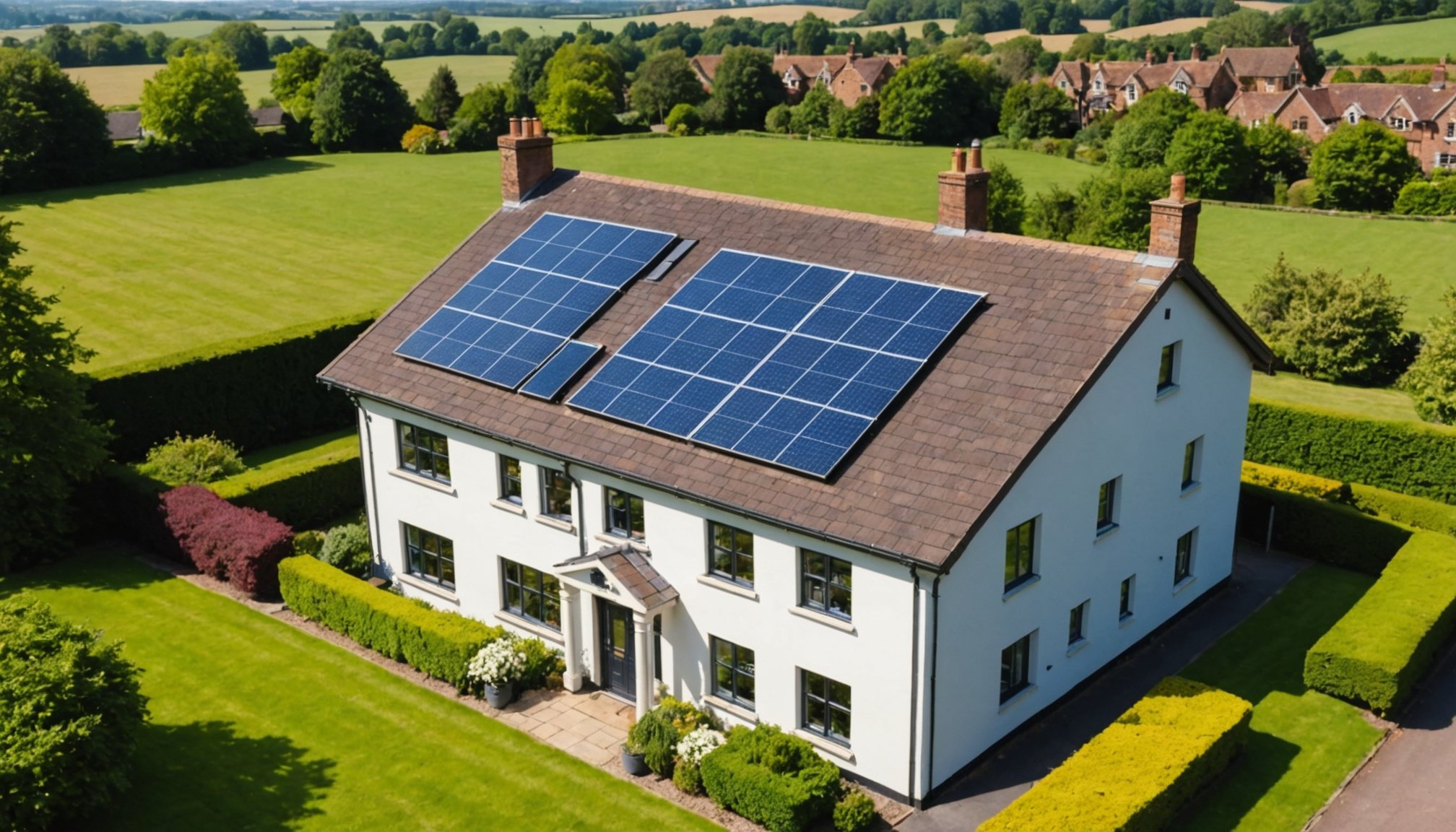Homeowners in the UK face mounting costs and uncertainty in the energy market. Solar energy offers a viable solution, allowing you to harness renewable resources while increasing your property’s value. This guide will equip you with practical strategies to maximize returns on your solar investments. Discover how making the switch can enhance your home’s appeal and improve long-term financial stability in an ever-evolving energy landscape.
Benefits of Solar Energy for Homeowners
Solar energy offers numerous benefits to homeowners, making it an attractive option for those seeking sustainable living solutions. One of the most significant solar energy benefits is its positive impact on the environment. By harnessing energy from the sun, homeowners reduce their reliance on fossil fuels, thereby decreasing their carbon footprint and contributing to a cleaner, greener planet.
A lire en complément : Navigating Development Restrictions: Essential Tips for Historical Property Owners in the UK
In addition to environmental advantages, solar energy can significantly enhance property value. Homes equipped with solar panels are often more appealing to potential buyers, as they promise reduced energy costs and a commitment to sustainability. This property value enhancement is a compelling reason for homeowners to consider investing in solar energy systems.
Moreover, solar energy provides substantial long-term savings on energy bills. Once the initial investment in solar panels is recouped, homeowners can enjoy reduced utility costs, sometimes even eliminating them entirely. This financial benefit is particularly appealing in regions with high electricity rates, offering a practical solution for budget-conscious homeowners.
A découvrir également : Mastering Tenant Turnovers: A Comprehensive Guide for UK Landlords to Streamline Property Management
Adopting solar energy is not only a step towards sustainable living but also a financially savvy decision. By investing in solar energy, homeowners can enjoy the benefits of reduced environmental impact, increased property value, and significant savings on energy bills.
Financial Implications of Solar Energy Investments
Investing in solar energy involves understanding the solar investment costs and exploring various financing options. The initial costs of solar installation can vary significantly based on the size and type of the system. Typically, these costs include purchasing solar panels, inverters, mounting equipment, and installation labour. However, government incentives and tax credits can help offset these expenses, making solar investment more accessible.
Homeowners have several financing options to consider. These include solar loans, leases, and power purchase agreements (PPAs). Solar loans allow homeowners to own their systems while spreading the costs over time. Leases and PPAs, on the other hand, enable users to pay a monthly fee for using solar energy without owning the system. Each option has its advantages, and homeowners should evaluate which best suits their financial situation.
The return on investment (ROI) for solar energy can be quite compelling. Typically, the payback period—the time it takes for savings to equal the initial investment—ranges from 6 to 10 years. Factors influencing ROI include local electricity rates, available incentives, and the amount of sunlight the property receives. Understanding these elements helps homeowners make informed decisions, ensuring solar energy investments are both environmentally and financially rewarding.
Installation Process for Solar Energy Systems
The installation process for solar energy systems involves several key steps, each crucial for ensuring optimal performance and safety. Initially, a site assessment is conducted to evaluate the roof's condition, orientation, and shading. This step helps determine the most suitable solar panel installation layout.
Choosing the right solar technology is essential. Homeowners must decide between monocrystalline, polycrystalline, or thin-film panels, each offering distinct efficiency levels and cost considerations. Monocrystalline panels, for example, are known for their high efficiency and sleek design, making them a popular choice despite their higher cost.
Once the technology is selected, the next step is designing the system. This involves calculating the necessary panel capacity to meet the home's energy needs and planning the arrangement for maximum sunlight exposure.
Hiring qualified installers is paramount. Experienced professionals ensure the system is installed safely and complies with local regulations. They handle electrical connections, mounting, and integrating the system with the home's existing power grid. Poor installation can lead to inefficiencies or safety hazards, highlighting the importance of professional expertise.
In summary, the installation process is a comprehensive journey from site assessment to choosing the right technology and engaging skilled professionals. This ensures a reliable and efficient solar energy system for homeowners.
Government Incentives and Support
Navigating the landscape of solar incentives in the UK can significantly ease the financial burden of adopting solar energy. The government offers various grants and funding options to encourage homeowners to invest in renewable energy schemes. These incentives are designed to make solar energy more accessible and financially viable.
Overview of Government Incentives: The UK government provides several schemes to support solar energy adoption. The Smart Export Guarantee (SEG) allows homeowners to earn money by exporting surplus energy back to the grid. Additionally, the Green Homes Grant offers vouchers to cover part of the installation costs, although availability and terms may vary.
Available Grants and Funding Options: Homeowners can explore local council schemes and national grants that may offer financial support for solar panel installation. These programs often have specific eligibility criteria, such as income thresholds or property type, which applicants must meet to qualify.
How to Apply for Government Support: To benefit from these incentives, homeowners should start by researching available programs and understanding their requirements. Applications typically involve providing proof of eligibility, such as energy assessments or property documentation. Engaging with certified installers can also help streamline the process, ensuring all necessary paperwork is completed accurately.
Maximizing Property Value with Solar Energy
Harnessing solar energy is a strategic way to increase property value, as it aligns with current market trends favouring sustainable living. Homeowners can employ several strategies to enhance their property's appeal and worth through solar installations.
Understanding local property market trends is crucial. In many regions, homes equipped with solar panels are in high demand, often fetching higher prices than those without. This is due to the growing awareness of energy efficiency and its long-term cost benefits. Homeowners should research these trends to gauge the potential value increase solar energy can bring to their property.
Effective marketing is another essential component. Highlighting the solar energy impact in property listings can attract eco-conscious buyers. Emphasise the benefits, such as reduced energy bills and environmental sustainability. Use professional photography to showcase solar panels aesthetically, making the home more appealing.
Additionally, consider the following strategies to maximise value:
- Energy audits to demonstrate efficiency improvements
- Documentation of savings and incentives received
- Maintenance records to assure buyers of system reliability
By leveraging these strategies, homeowners can significantly boost their property's market value, making solar energy a wise investment for the future.
Case Studies of Successful Solar Investments
Exploring solar success stories provides valuable insights into the benefits and challenges faced by homeowners who have invested in solar energy. These homeowner experiences highlight the diverse applications and outcomes of solar installations.
One notable case involves a family in Cornwall, who installed a 5kW solar panel system. Within three years, they reported a 40% reduction in energy bills and received SEG payments for excess energy exported to the grid. Their experience underscores the financial and environmental advantages of adopting solar energy.
Another example is a couple in Manchester who opted for a solar lease. This allowed them to enjoy immediate savings without the upfront costs. Their case study illustrates how different financing options can make solar energy accessible to a broader audience.
Key lessons learned from successful installations include the importance of site assessment and choosing the right technology. Homeowners emphasised the need for professional installation to ensure system efficiency and longevity. Additionally, they highlighted the value of understanding local incentives, which can significantly enhance the return on investment.
These real-life examples demonstrate the practical benefits of solar energy and offer guidance for those considering similar investments.
Comparison of Solar Solutions Available in the UK
Exploring various solar panel types is essential for homeowners considering solar solutions in the UK. The three primary types are monocrystalline, polycrystalline, and thin-film panels. Each comes with distinct advantages and limitations.
Monocrystalline Panels
Monocrystalline panels are known for their high efficiency and longevity. They are made from a single crystal structure, allowing for greater energy conversion. However, they tend to be more expensive than other types, which might be a consideration for budget-conscious homeowners.
Polycrystalline Panels
Polycrystalline panels, on the other hand, are made from multiple silicon crystals. They are generally less efficient than monocrystalline panels but are more affordable. This makes them a popular choice for those looking for cost-effective solar solutions UK.
Thin-Film Panels
Thin-film panels are lightweight and flexible, offering versatility in installation. They are less efficient compared to crystalline panels but perform well in low-light conditions, making them suitable for specific environments.
When comparing solar solutions UK, consider factors such as efficiency, cost, and installation space. Each type of panel has its own pros and cons, and understanding these can help homeowners make informed decisions tailored to their specific needs.
Frequently Asked Questions about Solar Energy
Homeowners often have numerous solar energy FAQs when considering this renewable energy source. Addressing these common concerns can help clarify the benefits and practicalities of solar installations.
What happens to solar panels on cloudy days? Solar panels still generate electricity on cloudy days, albeit at reduced efficiency. They can produce energy even in low-light conditions, ensuring a continuous power supply.
Are solar panels difficult to maintain? Maintenance is minimal. Regular cleaning and occasional inspections ensure optimal performance. Most systems are designed to be durable, with warranties often covering up to 25 years.
Will solar energy work for my home? Solar energy is viable for most homes, but factors like roof orientation, shading, and local climate can affect efficiency. A site assessment helps determine suitability.
How does solar energy impact my electricity bills? Solar panels can significantly reduce electricity costs. Any surplus energy generated can often be sold back to the grid, further decreasing expenses.
For those with additional homeowner questions, resources such as local solar energy providers and government websites offer detailed information and guidance, helping to dispel myths and support informed decision-making.
Visuals and Infographics to Enhance Understanding
Incorporating solar energy infographics into educational materials significantly aids in conveying complex information. Visual aids help break down data, making the benefits of solar energy more accessible and understandable.
Importance of Visuals
Visuals are crucial for simplifying intricate concepts. They allow homeowners to grasp the environmental and financial impacts of solar energy quickly. For instance, an infographic showing the reduction in carbon emissions can effectively communicate the environmental benefits compared to textual explanations.
Types of Infographics
Several types of infographics can be utilised to illustrate solar energy data. Data representation charts can depict energy savings over time, while comparative infographics can highlight differences between solar panel types. Process infographics are ideal for outlining the installation steps, offering a clear overview of what homeowners can expect.
Tips for Creating Engaging Visual Content
To create compelling visual content, focus on clarity and relevance. Use contrasting colours to highlight key points and ensure text is legible. Incorporate real-world data to make infographics relatable and trustworthy. Engaging visuals should also be shareable, encouraging homeowners to spread awareness about solar energy benefits.
By leveraging solar energy infographics, homeowners can make informed decisions, enhancing their understanding of solar technology and its advantages.











